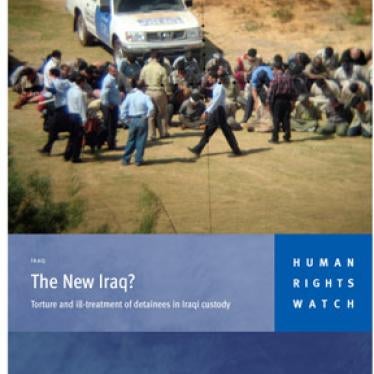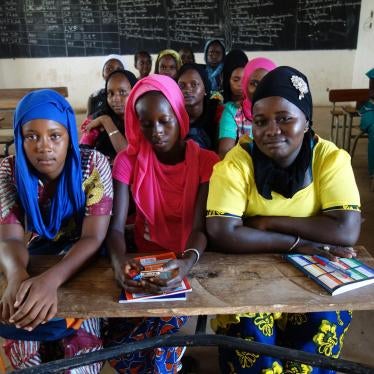In December 1999, Human Rights Watch first called for a global moratorium on the use of cluster bombs until humanitarian concerns can be adequately addressed.
When the submunitions contained inside cluster bombs fail to explode as intended, they become in effect antipersonnel landmines. Because of the high "dud," or failure, rate of the submunitions, and because of the large number typically dispersed over large areas, they have proven to be a serious and long-lasting threat to civilians, soldiers, peacekeepers, and even clearance experts.
It is clear that at the present time, the use of even the most sophisticated cluster bombs poses grave and unacceptable dangers to civilian populations. There should be no further use until governments can establish either that a technical solution is possible or that new restrictions and requirements regarding use can be effective.
Human Rights Watch asks that governments address this urgent humanitarian issue both domestically and at the international level. In December 1999 we recommended that the Convention on Conventional Weapons should be utilized as a means of establishing rules, restrictions, requirements, and/or prohibitions with respect to cluster bombs and their use that would minimize the dangers to and impact on civilian populations. In this regard, Human Rights Watch takes note of the proposal put forth by the International Committee of the Red Cross for a fifth Protocol dealing with explosive remnants of war.
Human Rights Watch holds that there should be no use of cluster bombs by any nation until:
- A definitive study is made of various ways of minimizing the impact of cluster bombs on civilian populations. This should include an examination of technical possibilities and options related to use and targeting.
- There is adequate research and analysis of past use of cluster bombs, including military usefulness, civilian impact, safety and overall effects.
- There is a serious legal review of cluster bombs and their consistency with international humanitarian law. This should include an assessment of whether they are inherently indiscriminate, prone to indiscriminate use, excessively injurious, cause unnecessary suffering, have a disproportionate impact on civilians compared to their military utility, or violate the dictates of public conscience.
Human Rights Watch believes that a successful approach to ameliorating the negative humanitarian impact of clusters must include the following:
- A prohibition on use in populated or urban areas.
- A requirement for accurate recording and mapping of cluster bomb use.
- Post-use requirements such as marking, warnings to civilians, clearance, and sharing of relevant information with appropriate clearance and awareness organizations.
HRW believes cluster bombs should not be used until it can be demonstrated that the failure rate of cluster bombs can be reduced to a tolerable level from a humanitarian perspective. That level should be determined by humanitarian and military experts, but should certainly be less than 1%.
On January 10, 2001, then-U.S. Secretary of Defense William Cohen issued a memorandum stating, "It is the policy of the DoD [Department of Defense] to reduce overall UXO [unexploded ordnance] through a process of improvement in submunition system reliability - the desire is to field future submunitions with a 99% or higher functioning rate.... The Services shall design and procure all future submunition weapons in compliance with the above policy."2
On the technical side, there needs to be:
- A realistic assessment of the failure rate of existing cluster bombs, which is often estimated anywhere from 2%-30%. There should also be an assessment if cluster bombs have a higher failure rate than other weapons that become unexploded ordnance, and if unexploded cluster bomblets are more volatile or dangerous than other UXO.
- An examination of options to improve the reliability and safety of cluster bombs, and of the factors that affect cluster bomb reliability and safety (including fuses and secondary fuses, number of bomblets, area coverage, dispersal pattern, method and circumstances of delivery, special features like incendiary rings, characteristics of the target area, age and design).
- An assessment of the feasibility and effectiveness of putting self-destruct, self-neutralizing and/or self-deactivating mechanisms on all cluster bombs, both new production and existing stocks.
On the use side, there needs to be:
- an identification of what constitutes a proper and effective use of cluster bombs.
- an assessment of the feasibility and effectiveness of various other potential restrictions on use aimed at avoiding collateral damage, including target limitations and high-altitude delivery.
Use of Cluster Bombs
The following nations are thought to have used cluster bombs: Eritrea, Ethiopia, France, Iraq, Israel, Netherlands, Russia, Sudan, United Kingdom, United States, FR Yugoslavia.
Among the countries affected by cluster bomb use are: Afghanistan, Bosnia, Cambodia, Eritrea, Ethiopia, Iraq, Kuwait, Laos, Lebanon, Russia (including Chechnya), Sierra Leone, Sudan, Vietnam, Yugoslavia (including Kosovo), as well as the Falkland/Malvinas Islands.
The United States has continued to use cluster bombs in Iraq. While great press attention was paid to new President George W. Bush's decision to bomb Iraqi targets on February 16, there was scant recognition that some U.S. jets used cluster bombs, those formally known as the Joint Stand-Off Weapon (JSOW). JSOW was first used in combat in Iraq more than two years ago, on January 25, 1999. The 1,000 pound, fourteen-foot-long weapon carries 145 anti-armor and antipersonnel incendiary bomblets that disperse over an area that is approximately 100 feet long and 200 feet wide.
More than 1,600 Kuwaiti and Iraqi civilians have been killed, and another 2,500 injured, by the estimated 1.2 million cluster bomb duds left following the 1991 Persian Gulf War, which saw the most extensive use of cluster bombs in history. Indeed, in February 2001 alone, there was at least one Iraqi death and nine injuries from unexploded cluster bomblets, presumably all left over from the 1991 war.
During Operation Allied Force in Yugoslavia and Kosovo, the U.S. dropped about 1,100 CBU-87 cluster bombs (each containing 202 submunitions), the U.K. dropped about 500 RBL-755 cluster bombs (each containing 147 submunitions), and the Netherlands dropped 165 CBU-87 cluster bombs. The fact that the Dutch used cluster bombs is little known. A total of 610 cluster bomb strike areas have been identified across Kosovo. Using a very conservative estimate of 5% failure rate, NATO forces left behind some 15,000 duds, waiting, like antipersonnel mines, to take lives and limbs during peacetime.
Since the conflict in Kosovo ended in June 1999, more than 500 people have been killed or injured by cluster bomblets, mines, and other UXO. U.S., U.K., and Dutch cluster bomb duds have been as much a problem for civilians and clearance specialists as landmines laid by Yugoslav forces and the Kosovo Liberation Army. The U.N. Mine Action Coordination Center in Kosovo reported that as of December 15, 2000, a total of 4,932 cluster bomblets had been cleared, in addition to 4,586 antipersonnel mines, 4,315 antitank mines, and 5,853 unspecified UXO. In its June-September 2000 quarterly report, the Center wrote, "During the previous quarter, it had been recognized that CBU [Cluster Bomb Units] were a major contributing factor to incidents involving civilians. In particular, CBU incidents generally involved groups of younger people, often with very tragic results."
In addition to the post-conflict casualties, Human Rights Watch believes there were nine to fourteen cluster bomb attacks resulting in civilian casualties during the conflict, causing an estimated 90-150 civilian deaths, or 15-26% of all civilian deaths, even though cluster bombs represented just 6% of weapons expended in the air war. A NATO air strike involving cluster bombs on an airfield in Nis on 7 May went off target, hitting a hospital complex and adjoining civilian areas. On 24 April, five boys were reported to have been killed and two injured when what was evidently a cluster bomb submunition exploded near the village of Daganovic.
Stockpiling of Cluster Bombs
The following forty-four nations are thought to have an arsenal of cluster bombs, either from domestic production or importation:
Africa- Eritrea, Ethiopia, Gabon, Nigeria, South Africa, Sudan
Americas- Argentina, Brazil, Canada, Chile, Mexico, United States, Venezuela
Asia- China, India, Indonesia, Pakistan, Singapore, South Korea, Taiwan
Europe- Belgium, France, Germany, Greece, Italy, Netherlands, Norway, Poland, Romania, Russia, Slovakia, Spain, Sweden, Turkey, United Kingdom, Yugoslavia
Middle East- Algeria, Egypt, Iran, Iraq, Kuwait, Qatar, Saudi Arabia, Syria, United Arab Emirates
Production of Cluster Bombs
The following nations are thought to be cluster bomb producers: Chile, China, France, Germany, Greece, Iraq, Israel, Netherlands, Pakistan, Poland, Russia, Singapore, Slovakia, Spain, South Africa, Turkey, United States, United Kingdom
Transfer of Cluster Bombs
The following nations are thought to have exported cluster bombs: Brazil, Chile, Germany, Israel, Italy, Russia, Spain, United Kingdom, United States
1 For the purposes of this memorandum, HRW is using "cluster bomb" as a short-hand, catch-all term for air- and surface-delivered dispensers containing unguided explosive submunitions.
2 Secretary of Defense William Cohen, Memorandum for the Secretaries of the Military Departments, Subject: DoD Policy on Submunition Reliability (U), January 10, 2001. The memo defines future submunitions as those reaching a production decision in fiscal year 2005 and beyond.








